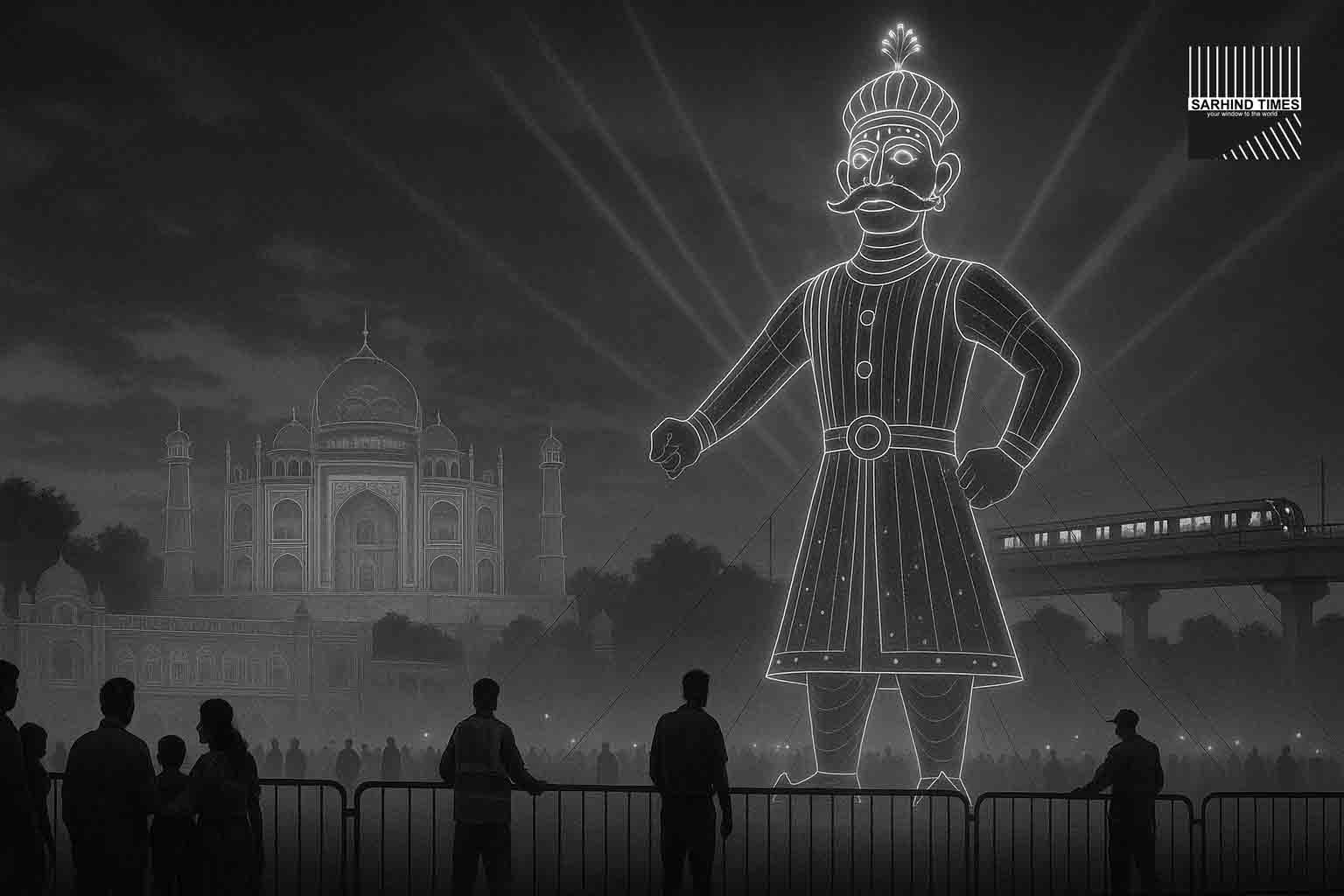By Sarhind Times City Desk | New Delhi | October 2, 2025
NEW DELHI: The capital’s Dussehra stages are set to look—and sound—different this year. Organisers across the city have layered traditional Ramlila performances with AI-assisted theatrics, 3D projection-mapped backdrops, LED-lit interactive effigies, and laser effects, promising a spectacle that blends mythology with modern showcraft. At marquee venues, effigies of Ravan, Kumbhakaran and Meghnad will tower over crowds—some approaching the 200-foot mark, according to committees preparing installations from the Red Fort lawns to Dwarka. Top dignitaries, including President Droupadi Murmu and senior political leaders, are expected at select events, with security and traffic diversions in place through the evening.
Delhi Police and civic agencies have issued advisories urging public-transport use, particularly around Old Delhi and East Delhi corridors that host high-footfall Ravan-Dahan ceremonies. Expect staggered restrictions on Netaji Subhash Marg (Delhi Gate–Chatta Rail Chowk), parts of Nishad Raj Marg, and routes abutting the Red Fort precinct through the night; commuters returning from Chatta Rail Chowk towards Delhi Gate have been guided to use Salimgarh Bypass.
Despite spells of rain earlier this week, committees report sold-out stalls and full crews, with technicians criss-crossing grounds to waterproof rigs and re-paint soaked surfaces. Artisans who scrambled to repair weather-hit effigy skins say the rush was worth it: this evening’s crowds are expected to be the largest of the season.
What’s new on stage: the “AI + LED + 3D” toolkit
This year’s show blueprint is simple: keep the story familiar; upgrade the canvas. Committees are using AI-assisted scene planning (pre-viz and lighting cues), projection mapping for battles and cityscapes, servo-controlled moving parts on effigies (rotating heads, sword-arm sweeps), and LED pixel strips that pulse with sound design. A few organisers have added a fourth “social evil” effigy—a rotating theme that channels contemporary concerns—burned alongside the Lanka trio to land a modern moral.
The technology isn’t entirely new to Delhi’s Ramlilas—but the scale and coordination are. Crews have borrowed techniques from music festivals and wedding sangeets, syncing timecode across pyros, lasers, and projection playlists. In practice, that means a tighter, more rhythmic show: conches and chorus lines on cue; the Pushpak Viman flying in on a crane at the exact bar; arrows streaking across 3D skies just as the LED eyes on Ravan flare. PTI and city outlets have chronicled weeks of prep for 3D-tech, LED and tribute segments, particularly at Old Delhi’s high-profile committees.
The big builds: how tall is “tall” this season?
While Kota is gunning for record books this year with a 221.5-ft Ravan, Delhi’s top installations aren’t far behind. Committees at Red Fort and Dwarka have spoken of 100- to near-200-ft builds—ambitious, wind-sensitive structures whose internal frames are now engineered with segmented bamboo, light steel, and flame-tuned “green” pyros. A ToI clip from Dwarka Sector-10 showcases one of the season’s tallest Delhi builds already in place.
The allure of scale is obvious, but organisers say spectacle today is as much horizontal as it is vertical: wider screens, deeper stages, longer fire lanes, and safer burn choreography. That is why many committees have shifted to laser sequences + green crackers and controlled ignition points, with pre-programmed sequences replacing chaotic bursts.
VIP calendar, security rings and what it means for you
Protocol traffic around major grounds will intensify at dusk. VIP attendance—from Rashtrapati Bhavan to senior political leadership—is expected at Old Delhi and other prominent grounds; Prime Minister Narendra Modi is slated to join a Dussehra ceremony in East Delhi’s Patparganj area around 6 pm, per day-of reports. That means security cordons, frisking gates, and bag checks—with a premium on arriving early and travelling light.
Traffic watch (key notes):
- Avoid / expect restrictions: Netaji Subhash Marg (Delhi Gate–Chatta Rail Chowk), Nishad Raj Marg, and feeder lanes around Red Fort. Use Salimgarh Bypass when returning.
- No-parking zones: Stretches of Bahadur Shah Zafar Marg, JLN Marg, Ring Road (Hanuman Setu–Rajghat), and I.P. Flyover–Pragati Maidan Tunnel flagged in advisories today. Plan for Metro + first/last mile.
Tip: If you’re heading to Old Delhi, exit two Metro stations away and walk in. It’s often faster than a last-mile gridlock.
Weathered, not washed out: salvaging the week after showers
A mid-week downpour soaked hundreds of effigy skins, forcing overnight repair and re-paint across workshops in Delhi and NCR. Artisans told local press they re-stitched segments, dried lattice frames, and re-sealed ignition lines to keep Thursday timelines intact. The visual payoff is visible now: freshly lacquered faces, cleaner silhouettes, and waterproofed seams that should hold even if humidity spikes tonight.
Red Fort, Dwarka and beyond: how committees are differentiating
- Red Fort lawns (Luv-Kush Ramlila): Large-format 3D backdrops, celebrity appearances, and a crowd-management plan built around faster gate churn and dedicated medical bays. Local media also note a celebrity “Ravan-Dahan” guest this year.
- Dwarka grounds: A focus on sheer scale—one of Delhi’s tallest effigies—paired with LED-mapped armor that glows on cue.
- Indraprastha & neighbourhood Ramlilas: Fourth effigy themes and “vote-your-evil” campaigns that crowdsource what the add-on effigy should symbolize, then burn it with the Lanka trio.
- Tech trend everywhere: PTI round-ups from early September flagged a city-wide embrace of 3D tech and LED lighting; Moneycontrol’s city feature logged a friendly one-upmanship among committees on size, effects and guest lists.
Behind the curtain: the show is a supply chain
A seamless Ravan-Dahan asks for more than matchmaking fire to paper. There’s rigging, structural math, electrical load mapping, and last-mile risk management. On a typical day like today:
- Load-in (AM–noon): Final projector alignment, focus pulls, sound checks, DMX/Art-Net patching for lights, and safety walks.
- Dress rehearsal (afternoon): One “dry” run of the main montage—timings locked for LED, lasers, pyros, and crane lifts.
- Gates (5–6 pm): Barricades tested; emergency corridors cleared; medics briefed.
- Show (7–8:30 pm): Rama’s arc accelerates via fast-cut sequences; effigies ignited on pre-timed cues; drones kept grounded near VIP perimeters.
- Load-out (post-show): Rapid debris clearance; e-waste segregation; ground restoration.
The point is simple: today’s “traditional” show is logistically closer to a touring concert than a small-town fair. That shift explains why committees increasingly hire professional stage managers and projection specialists, even as volunteers anchor the cultural spine.
Safety stack: lessons learned and applied
Fire lanes & ignition: High-rise effigies now use multi-point sensors and remote-triggered sequences—a technique widely reported from record-seeking builds this year. It reduces flare unpredictability and keeps embers away from spectator zones.
Green crackers & lasers: Organisers at larger venues emphasise “green” formulations, lower smoke, and laser “sky-arrows” to supplement pyros. While visuals land, particulate load eases a notch—useful in a city where AQI messaging is sharper than ever.
Crowd control: Staggered entries, one-way loops, and choke-point marshals are standard tonight, especially at grounds expecting VIP arrivals. Public-address scripts now include clear exits and lost-and-found instructions.
First-aid: On-site ambulances, burn kits, and hydration points—a must on muggy evenings.
Getting there: a short viewer’s guide
- Metro first. Red Fort area is best approached via Lal Qila/Jama Masjid (walkable) or a stop farther to avoid crush. Pack light; expect frisking.
- For Dwarka: Use Blue Line and last mile by e-rickshaw; Sector-10 grounds will be sign-posted from the station.
- For East Delhi venues: Check the Patparganj/IP Extension advisories; plan to arrive ahead of VIP movement.
- If driving: Respect no-parking zones flagged today (Bahadur Shah Zafar Marg, JLN Marg, Ring Road segments, IP Flyover–Pragati Maidan Tunnel). Tow-aways are likely.
Culture meets code: why tech helps the story land
Critics sometimes ask why a moral parable needs lasers. The committees’ answer: reach. A 21st-century audience—raised on streaming, reels and stadium shows—responds to scale and clarity. Projection mapping can paint Lanka where real sets cannot; AI pre-viz helps tighten beats so families with kids stay engaged; LEDs read from 200 metres away. The story remains Valmiki’s; the stage language is updated so the youngest in the crowd “gets it” without footnotes.
The dignitary factor: optics and logistics
Presidential or Prime Ministerial presence at Dussehra grounds is as much about civic affirmation as it is about crowd warmth. The optics—a national leader pressing the ignition—travel far on television and social feeds. For the ground teams, though, it’s logistics: advance security sweeps, RF-restricted bubbles, and hard starts that stay on schedule. Newsrooms across the city have tracked today’s VIP grid; one live report pegs the PM at East Delhi’s Patparganj event this evening.
The economy of a night like this
A Dussehra evening is a micro-economy: paper crafts, bamboo, welders, riggers, sound techs, projectionists, vendors, food courts, parking crews, and clean-up teams. When rain intrudes, artisans lose inventory; when crowds swell, vendors catch a break. That is why committees aimed to keep momentum despite mid-week showers—the festival’s last night is when most of the season’s earnings are realized.
Beyond the big two: neighbourhood Ramlilas matter
Not every family will trek to Red Fort or Dwarka. Neighbourhood Ramlilas—in parks, school grounds, housing-colony maidans—carry the festival’s pulse to street level. Several have adopted scaled-down tech: a single short-throw projector for a palace wall, a rented LED arch, a slimmed-down light plot. In some ways, these smaller shows preserve Dussehra’s community grammar: volunteers you know, a stage you grew up with, prasad you recognize.
What to keep in mind tonight (quick public checklist)
- Arrive early; carry water; pack light.
- Use Metro and walk the last stretch; expect bag checks.
- Pick a landmark to regroup if your group fragments.
- Ear protection for young children near main pyros.
- Dispose responsibly; these are public grounds with tight post-show turnarounds.
After the blaze: clean-ups and credits
By Friday morning, crews will be back to lift ash, segregate metal skeletons, and restore turf. One reason committees are leaning into green pyros and laser-heavy sequences is exactly this: faster clean-ups, lower emissions, and fewer scorch marks to remediate. It’s the unglamorous end of a glamorous night, but it’s also where a city’s festival discipline shows.
The arc of a modern Ramlila
From live narrators under halogen bulbs to synced projection-laser suites, Delhi’s Ramlila has ridden four decades of stage evolution without losing its moral centre. If anything, the modern grammar—AI pre-viz, 3D mapping, LED skins—has made it easier to scale the parable to vast city crowds. And when the arrow arcs and the effigy lights, the cheer that follows is not for the tech, but for the idea: the victory of good over evil, retold so every generation can see itself in it. That, more than the lasers, is what fills the grounds.
#Dussehra #RavanDahan #Delhi #AI #3DProjection #Festivals #TrafficAdvisory #Culture




















+ There are no comments
Add yours